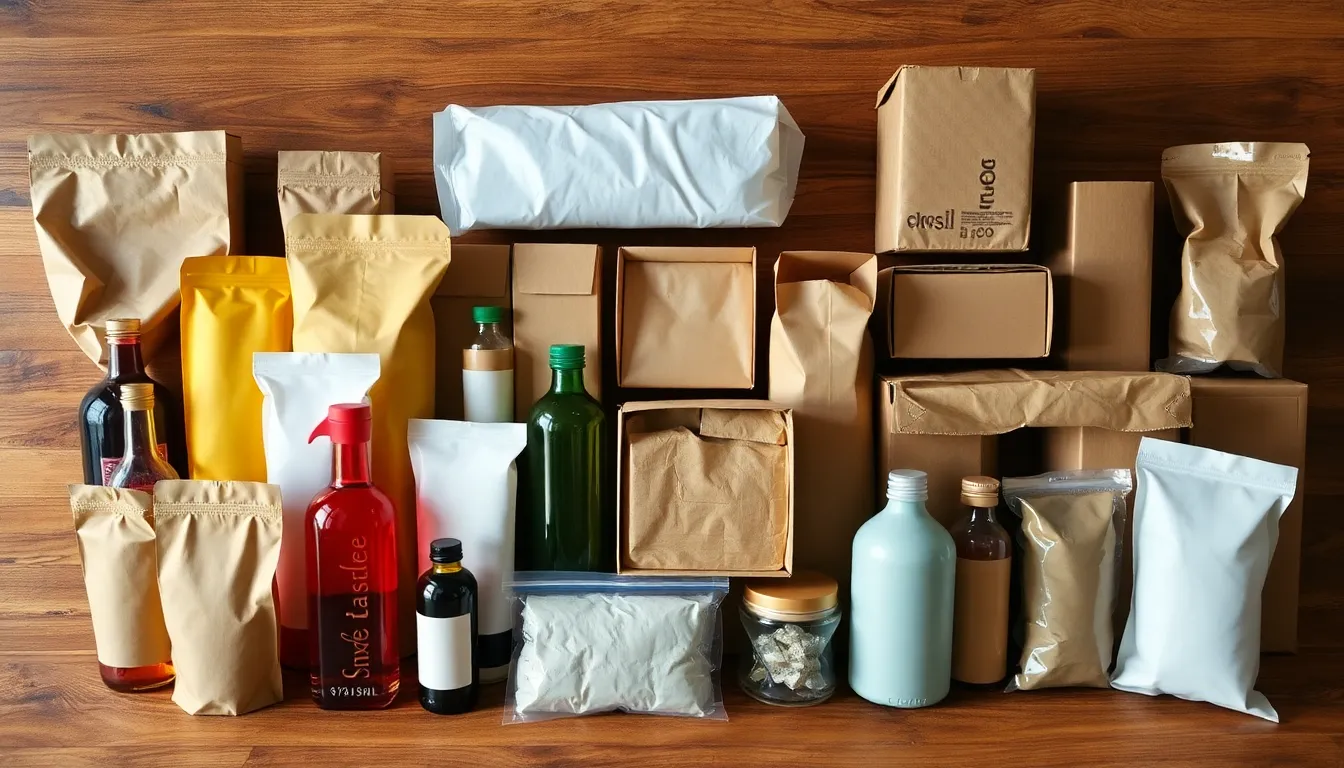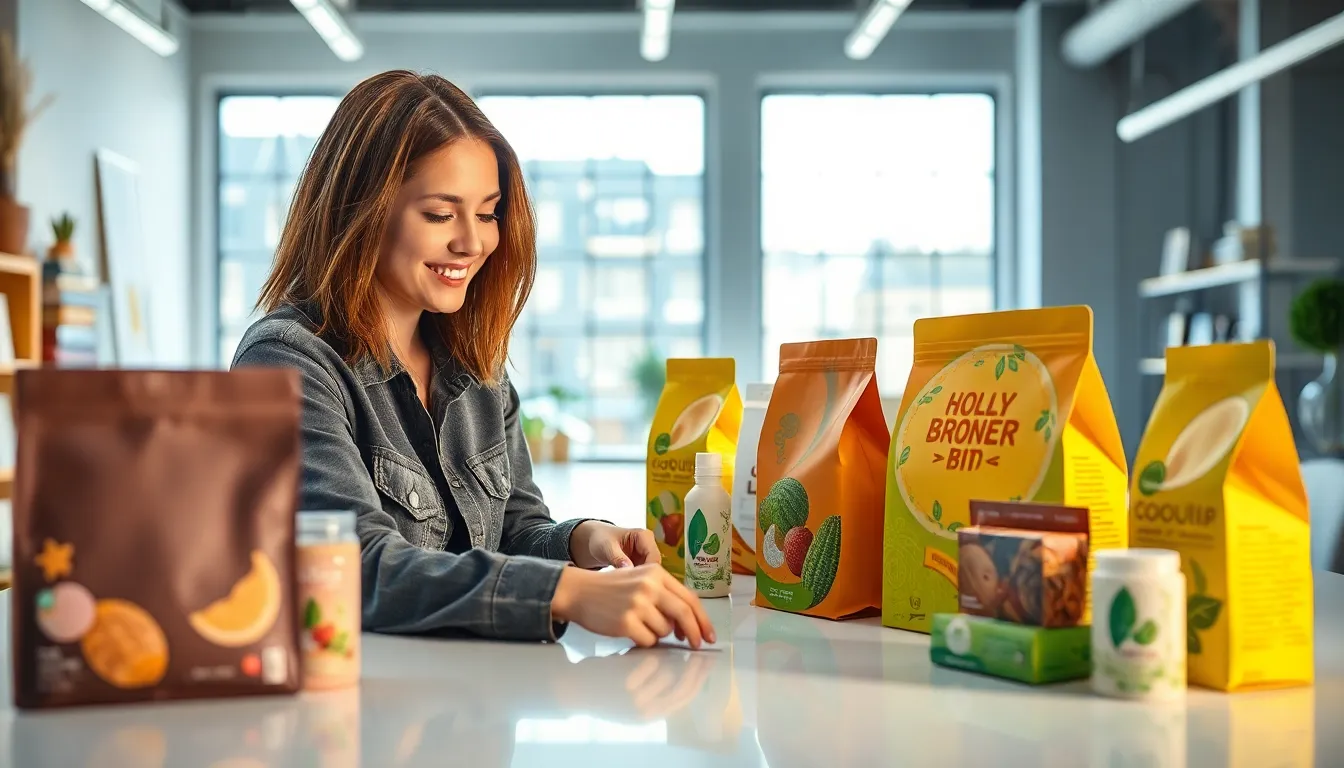In a world where first impressions matter more than ever, packaging isn’t just a pretty box; it’s the unsung hero of marketing. Imagine walking down a store aisle, and one quirky package catches your eye like a neon sign in a blackout. That’s the power of great design! It’s not just about keeping products safe; it’s about telling a story, sparking curiosity, and sometimes even making you chuckle.
From eco-friendly materials to eye-popping graphics, packaging concepts have evolved into an art form that blends functionality with flair. Brands that master this balance don’t just sell products; they create experiences. So whether it’s a snack that promises to make you feel like a kid again or a beauty product that whispers luxury, the right packaging can transform the mundane into the magical. Let’s dive into the fascinating world of packaging design and discover how it shapes our buying decisions.
Table of Contents
ToggleUnderstanding Packaging Concepts and Design
Packaging plays a vital role in connecting products to consumers, creating lasting impressions that influence purchasing behavior. Effective design integrates creativity and functionality, ensuring that products not only attract attention but also meet consumer needs.
Importance of Packaging in Marketing
Packaging serves as a brand’s first touchpoint with consumers. Captivating designs spark interest and promote brand recognition. Statistics show that 72% of consumers decide whether to purchase based on packaging alone. In competitive markets, unique and innovative packaging can differentiate products, driving sales and brand loyalty. Engaging packaging doesn’t merely protect products; it communicates brand values and story. When consumers connect emotionally with packaging, it enhances their purchasing experience.
Elements of Effective Packaging Design
Several key elements define effective packaging design. Clarity in information ensures consumers quickly understand product benefits. Visual appeal captivates attention through creative use of colors, shapes, and typography. Functionality encompasses ease of use and safety, influencing how products are perceived and interacted with. Sustainability emerges as a critical factor, with eco-friendly materials attracting environmentally conscious consumers. Consistency in branding across all packaging reinforces brand identity and fosters trust. Each element works together to create a cohesive representation of what the product offers.
Types of Packaging

Packaging serves various functions, each addressing specific needs in product storage, protection, and marketing. Understanding the different types of packaging helps in creating effective designs that resonate with consumers.
Primary Packaging
Primary packaging directly encases the product, ensuring safety and integrity. It includes containers like bottles, jars, and bags that are immediately visible to consumers. Customization of primary packaging often incorporates branding elements, which can enhance shelf appeal. Materials frequently used consist of glass, plastic, and metal, each offering unique benefits. Attractive designs in primary packaging can create emotional connections and influence purchasing behavior.
Secondary Packaging
Secondary packaging groups multiple primary packages, facilitating transportation and storage. Examples of secondary packaging include boxes and trays that hold several items together. This type enhances branding opportunities through larger surface areas for graphics and product information. Once it reaches retail locations, secondary packaging simplifies handling for retailers. Efficiency in design minimizes waste and aligns with sustainability goals, potentially impacting consumer perception positively.
Tertiary Packaging
Tertiary packaging supports bulk handling and shipping, providing added protection during transport. Common forms include pallets, crates, and shrink wrap designed to secure large quantities of products. Businesses utilize tertiary packaging to optimize space in warehouses and enhance distribution efficiency. Additionally, it reduces the risk of damage while moving goods through various channels. Effective tertiary packaging design can lead to cost savings and streamlined logistics, benefiting overall operations.
Key Principles of Packaging Design
Packaging design centers on several key principles that enhance both the product’s appeal and its functionality. These principles help brands establish a strong presence in the market while addressing consumer needs.
Functionality
Functionality serves as a cornerstone of effective packaging design. Each package must protect the product without compromising accessibility. Users appreciate designs that simplify opening, pouring, or dispensing, enhancing the overall user experience. Durability also plays a vital role, as packages must withstand transport conditions and potential mishandling. Good functionality minimizes waste and prevents product damage, contributing to customer satisfaction and loyalty.
Aesthetics
Aesthetics significantly impact consumer perceptions and purchasing decisions. Packaging should grab attention with visually appealing colors, shapes, and graphics. Creativity in design not only draws the eye but also communicates the brand identity and values. Unique packaging designs often lead to a stronger emotional connection between the consumer and the brand. Additionally, striking aesthetics enhance the product’s visibility on shelves, increasing the likelihood of purchase among competing products.
Sustainability
Sustainability increasingly influences packaging design. Eco-friendly materials resonate with consumers who prioritize environmental responsibility. Brands that adopt sustainable practices often enhance their image and build trust with their audience. Packaging that is recyclable, biodegradable, or made from renewable resources reflects a commitment to reducing waste. Sustainable designs not only appeal to ethically-minded consumers but also comply with regulations promoting environmental protection and conservation.
Current Trends in Packaging Concepts
Current trends emphasize sustainability and innovation in packaging design. Brands increasingly prioritize eco-friendly practices that resonate with environmentally conscious consumers.
Eco-Friendly Packaging Solutions
Eco-friendly packaging solutions focus on minimizing environmental impact. Biodegradable materials like plant-based plastics and recycled paper gain popularity, appealing to conscious buyers. Consumers prefer brands using reduced packaging, enhancing their perception of overall value. Transparent sourcing practices provide further assurance about sustainability. Moreover, certifications like FSC ensure responsible forestry practices.
Innovative Materials and Technology
Innovative materials and technology are reshaping the packaging landscape. Smart packaging incorporates sensors that monitor freshness and track product conditions, improving user experience. Companies invest in lightweight materials that reduce transportation costs and carbon footprints. Additionally, digital printing technologies allow for customization at scale, enhancing branding efforts. Brands adopting these advancements showcase commitment to quality and modernity, influencing consumer trust and loyalty.
Effective packaging is more than just a protective layer; it’s a vital component of a brand’s identity. By integrating creativity with functionality brands can create memorable experiences that resonate with consumers. As the market continues to evolve the emphasis on sustainability and innovation will only grow stronger.
Brands that embrace these trends not only enhance their appeal but also build lasting connections with their audience. The right packaging can transform a simple product into a compelling story that captures attention and drives sales. Ultimately, thoughtful packaging design is an investment in a brand’s future success.

